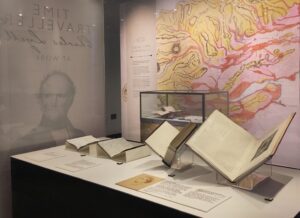By Morven Rodger, Collections Registrar, Heritage Collections
As the Collections Registrar, one of my core responsibilities is coordinating loans from the University’s Heritage Collections to external exhibitions. Whenever an item from our collections is requested by another institution, I work with our conservators, curators, and technicians, while liaising with the borrowing institution, to manage the risks and help make the process as smooth as possible.
I am always excited by new loan requests, and the prospect of sharing our collections with broader audiences, but no loan is without risk, and lenders must balance the risks and benefits to justify their decision to lend. The loan request is a borrower’s opportunity to make their case, explain why they want to borrow, show that they understand the practicalities, and demonstrate the value our items will add to their exhibition.
 There are many reasons an exhibition may include loans from another collection; to build partnerships with other institutions, add research value, bring new audiences to an exhibition, and address storytelling gaps or biases in an existing collection. In our recent exhibition, Time Traveller: Charles Lyell at Work, curators chose to highlight the work of Lyell’s secretary, Arabella Burton Fisher (née Buckley), using loans from the National Library of Scotland to tell her story and supplement the University’s collections.
There are many reasons an exhibition may include loans from another collection; to build partnerships with other institutions, add research value, bring new audiences to an exhibition, and address storytelling gaps or biases in an existing collection. In our recent exhibition, Time Traveller: Charles Lyell at Work, curators chose to highlight the work of Lyell’s secretary, Arabella Burton Fisher (née Buckley), using loans from the National Library of Scotland to tell her story and supplement the University’s collections.
Loans can take months, even years to plan. Most UK museums require in the range of 6-12 months’ notice for loan requests, to enable them to allocate resources and plan around other activities. This information is typically published online but is often hard to navigate, and I sometimes resort to googling “[insert museum name] exhibition loans” to find the relevant details!
The next step is research. Basic object details can usually be found online, but it’s helpful to make informal contact with collections staff at the lending institution as early as possible. They can provide much more detail, and an idea of what’s achievable, while drawing your attention to details which will make a compelling request.
If possible, it’s a great idea to visit in person and view the items first hand. We make our collections available for in person research visits in our reading room, or for virtual visits online. This is a great way to get a clear impression of the scale and materiality of an item, visualise how it will fit into your display and consider the costs and practicalities.
It may be tempting to make a speculative loan request and cancel it if things don’t pan out, but withdrawing a request can affect the lender’s impression of the borrower and make them less willing to lend in future. When a new loan request is received, staff at the lending institution will invest time into researching the request and condition checking the item, etc., so it’s best not to trigger this process until you have done your homework!
A formal loan request should be made in writing, addressed from Director to Director. A basic request letter should include exhibition dates, venue, object details, a summary of the exhibition and plans for insurance or indemnity, but a good request will go into detail about the objects, why they are important to the exhibition, and what would be missing without them. Lenders will want to know the purpose and themes of the exhibition, and the context in which the borrower wishes to display and interpret their items.
If you are interested in requesting loans from the University’s Heritage Collections, please contact us, or visit the Loans & Lending pages of our website.

Hello. Fascinating insight into rightfully complex issues. As volunteer with UoE Heritage Collections at crc, privileged to view items there and informative to learn about loaning procedures. Many thanks.